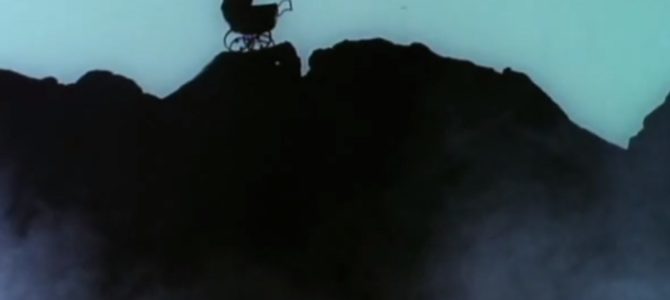
A bizarre feature of the Vietnam era was that, although God was “dead,” Satan was alive and well. It certainly seemed that he was making a comeback, with the more nihilistic elements of the Vietnam protesters forming “covens” and enthusiastically performing the requisite rituals of witchery by desecrating Christian symbols, bowing before statues of Satan, and finishing off with a mass orgy.
True to form, agnostic Hollywood saw big box office in the built-in appeal that Satan possessing the young had for a “Greatest Generation” shocked and appalled by their potty-mouth, flag-burning children: “The Devil,” not their parenting, “made them do it.”
Because of its controversy and popularity, many believed “The Exorcist” (1973) followed by “The Omen” (1976) pioneered the subversive idea that children could be Satanic villains. But it actually began with Ira Levin’s “Rosemary’s Baby” (1968), faithfully brought to screen by art house director Roman Polanski a year later. In three weeks an artsy commemorative book debuts marking the fiftieth anniversary of this film: “This Is No Dream: Making Rosemary’s Baby,” by James Munn and Bob Willoughby.
Ironically, Levin, the author of this tale of modern Satanism, was a New York atheist. But he was able to ground this tale of the birth of the anti-Christ in such realism that he earned a rave review by Truman Capote.
A decade later, Hollywood would produce another anti-Christ film, “The Omen,” which had as its villain a little boy. But Levin’s tale was far more subversive. He grounded the event leading up to the birth of Satan’s son in that most atheistic of cities, New York, and cast as its sinister villains old New Yorkers who, between complaining about the heat and taxi strikes, practiced Satanism.
This coven wanted more from their new neighbors—the agnostic and financially struggling Guy and Rosemary—than sugar. Aided by Guy, brought in with the promise of a successful acting career, this coven tricked Rosemary into giving birth to a child of the Devil.
Even before publication, Hollywood was interested. Originally the film was to be made as a B movie for drive-ins. However, the producer of Paramount studios at the time, Robert Evans, wanted the film to be a major production. To effectively imbue the movie with an atmosphere of coiled conspiracy, he got Polanksi to leave his native Poland to make the film.
Polanski, a Polish director who lost much of his family to the Holocaust, had made several art-house pictures that reflected his belief that evil always triumphed. Hence there was an air of inevitability for Polanski and “Rosemary” finding each other. In his hands, this subversive tale would be made even more so.
To enhance the horror, Polanski cast into the roles of the Satanic coven sturdy “establishment” types from Hollywood’s Golden Age, a period for whose morality and patriotism the Silent Majority pined. Leading the cast was Ralph Bellamy, who owed his career to playing a bumbling hayseed manipulated by a streetwise Cary Grant. But the most shocking casting of all was Hope Summers as a chanting Satanist (“All Hail Satan”). She was then starring as the small-town, church-going Clara on “The Andy Griffith Show.”
In other hands, the sight of these geriatric representatives of the “kinder gentler” FDR era appearing nude and cheering on Satan’s rape of Rosemary could have come off as a campy mess. But in Polanski’s hands, it was beyond horrific. Nowadays “possession” films seek to topple the genre gold standard, “The Exorcist,” with more gore. But Polanski knew that fleeting glimpses of Satan’s yellow eyes and claws were far more frightening than any head-swiveling violence.
Even more impressively, Polanski was able to provide a lurking conspiracy long before the Watergate era, upon which “The Exorcist” and “The Omen” relied heavily.
This lavishly illustrated book provides an ironic backstory to the film. The star of the film, Mia Farrow, was selected because of her fragile qualities. Her husband, Frank Sinatra, divorced her for appearing nude in the Satan rape scene. Polanski used her grief upon receiving the divorce papers on the set to film a scene where Rosemary cries uncontrollably.
Initially Polanski had wanted to cast his girlfriend, Sharon Tate, as Rosemary. But the producers didn’t think she projected vulnerability. A year later she was murdered, while pregnant, by a Satanic cult, the Manson family.
Despite the countless anti-Christ films that have popped up since 1968, “Rosemary’s Baby” remains the best and most subversive of this genre. Levin and Polanski gave audiences of that era another reason not to trust the over-30s.









